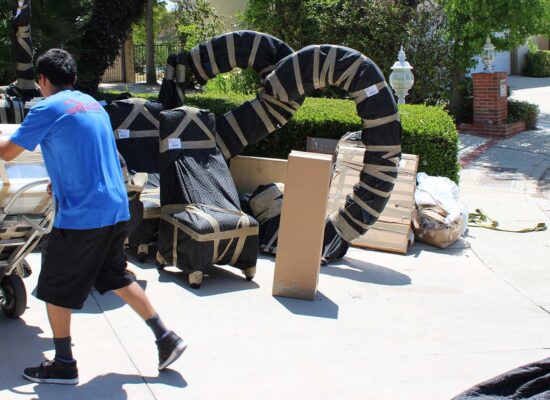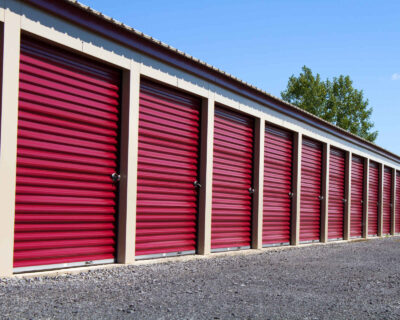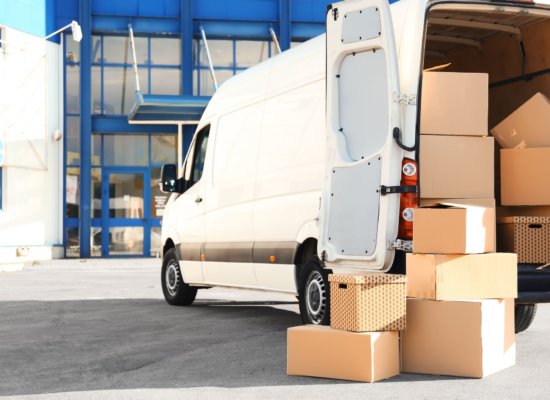The Ultimate Guide: How to Do a Home Inventory When Moving Across the Country
Embarking on a cross-country relocation? Our excellent guide on how to do a home inventory will be your essential companion. This step-by-step resource simplifies the daunting task of creating household inventories, reducing stress, preventing loss, and ensuring a smooth transition to your new residence. From categorizing possessions to utilizing the latest apps, our guide provides invaluable strategies for a successful relocation experience.

Before relocating to a new state, you should create a household inventory checklist. Choose a method for your relocation inventory – paper version, digital version, or combined approach. This process should be done room by room, with some special considerations for valuable items. When you finish with this task, reach out to long-distance movers from a moving and car shipping company for packing assistance.
What Is the Purpose of a Home Inventory?
This is a comprehensive list of all personal possessions in your residence, often supplemented with descriptions, values, and photographs. A detailed relocation inventory isn’t just a useful tool during a move when you have to decide what to keep – it’s a critical asset for homeowners and those renting an apartment alike. But what exactly is its purpose? Let’s delve into the various benefits and reasons to relocate with inventories when going to live in a new state.
Assisting With Insurance Claims in Case of Loss or Damage During the Move
One of the most significant benefits of inventories is their value in case of loss or damage during the move. No matter how cautious we are, accidents happen. Fragile or even large items may be lost, broken, or damaged in transit, and comprehensive inventories can greatly simplify the process of making an insurance claim.
They provide proof of ownership, making it easier for you to provide a detailed account of what was lost or damaged. Additionally, they can also help determine the correct amount of insurance coverage you should have for your belongings.
Facilitating Organization and Tracking of Belongings During the Relocation Process
This list can be a lifesaver for organizing a move. It helps keep track of what you own, where it is, and where it needs to go in your new home. You can use it as a master new apartment checklist to check off items as they are packed efficiently, moved, and eventually unpacked. This not only provides peace of mind but also eliminates the confusion and chaos often associated with relocating long distances.
Providing a Reference for Decluttering, Packing, and Unpacking at the New Location
Creating a home inventory also provides an excellent opportunity for decluttering and getting rid of items when relocating. As you catalog your items, you can easily identify those that you no longer need or use, and decide whether to sell, donate unwanted items, or discard them.
When the time to pack comes, your catalog can guide you in packing similar items together for easier unpacking after the move. Moreover, once you arrive at your new place, it can serve as a blueprint for arranging your belongings, making the process of settling into your new space more efficient and less stressful.

Choose a Home Inventory Method
When making an inventory list, your first decision will be to choose a method that best suits your needs and comfort level with technology. There are several ways to conduct inventories, each with its own advantages and drawbacks. We’ll discuss the most common methods in the text below – traditional paper-based inventory, digital one, and a combination approach.
Traditional Paper-Based Version
For those who prefer a more tactile, straightforward approach, a traditional paper-based list can be an excellent method. This can be as simple as grabbing a notebook and pen (just like you would when writing a relocation to-do list) and writing down every item in each room. If you like to be more organized, you might prefer using a spreadsheet or a printable template, where you can categorize items room-by-room or by type of item.
The benefits of this method include its simplicity and its accessibility, as it doesn’t rely on technology. However, it can be time-consuming, and if the paper is lost or damaged, all your work will be lost as well. Therefore, if you opt for this method, it’s advisable to keep a copy of your inventory in a safe, separate location.
Digital Version
A digital inventory takes advantage of technology to make the process more efficient and secure. There are several home inventory apps and software available that allow you to catalog your belongings easily. Many of these tools allow you to add photos and receipts, organize items for packing by room or category, and even estimate the value of your belongings.
Digital inventories are generally more flexible and easy to update than their paper counterparts. They can also be backed up to the cloud, ensuring they won’t be lost if your device is damaged or stolen.
Combination Approach
For many people, the best approach may be a combination of both paper and digital methods. This approach allows you to reap the benefits of both systems, providing both the tactile satisfaction and straightforwardness of a paper and the flexibility and security of a digital list. You could start by creating a basic paper inventory, then transferring this information to a digital tool. This method also gives you a backup copy, offering additional peace of mind.

How to Do a Home Inventory? Here’s a Step-By-Step Guide for Conducting a Room-By-Room Home Inventory
Conducting inventories of household goods may seem daunting, given the number of items you own. But by adopting a systematic, room-by-room approach, the task can become more manageable and even therapeutic as you sort through your possessions. It allows you to break down the massive task into smaller, more digestible parts, reducing the chance of overlooking items and creating a better-structured catalog.
Start With One Room at a Time, Systematically Documenting Each Item
Begin your household inventory journey by focusing on one room at a time. You can start with any room – maybe the one with fewer items to gain momentum or the one with more valuable items for peace of mind. As you progress, document each item in the room, no matter how insignificant it might seem. Don’t forget to catalog items stored in closets, drawers, and cabinets.
Record Item Descriptions, Purchase Dates, Values, and Any Relevant Additional Details
As you list each item, be as detailed as possible in your descriptions. Record the brand and model, purchase date, and estimated value. For items of significant value, keep a copy of the purchase receipt or any appraisal documents, if available. For heirlooms or unique items, you may want to record the story or origin of the item. This detailed documentation is beneficial for insurance purposes and when unpacking or redecorating your future home.
Take Clear Photographs or Videos of Each Item to Supplement the Inventory Record
Visual records can be incredibly valuable when it comes to a household catalog. Take clear, well-lit photographs or videos of each item, paying special attention to any unique or identifying features. These visual aids can help prove the existence and condition of items in case of loss or damage, and they’re useful for jogging your memory about where items were located or how they were displayed in your previous residence.
Storage Service
Knowing what kind of surprises cross country move may hold, we offer 30 day free storage for belongings at the origin state.
Read moreAuto-Transport
If your first concern is having your vehicle transported safely and efficiently, enclose shipping is the way to go.
Read moreMoving Insurance
Flat Price Moving and Auto Transport Company offers moving insurance to cover potential damages
Read moreOrganize the Catalog by Room and Categorize Items for Ease of Reference
After documenting items, it’s crucial to organize your catalog for ease of reference. Arrange your list by room and further categorize items within each room. For instance, in the kitchen, you might have categories for electronic appliances, cookware, and dinnerware. This structure will make it easier to locate specific items in your catalog and can be helpful when packing and unpacking, allowing you to keep related items together.

Are There Some Special Considerations for Valuable Items?
When creating a household catalog, it’s important to give special attention to valuable or high-ticket items. These often require additional documentation and care in the relocation process. For items in this category, it’s crucial to document as many details as possible. This includes recording the item’s origin or history, any appraisals, and condition reports. If you have original purchase receipts or certificates of authenticity, these should be attached as well.
Take clear, high-resolution photos from multiple angles to capture the item’s condition and unique features. For jewelry and other valuable accessories, write detailed descriptions, noting the material (gold, silver, platinum), the type and number of gems, and any engravings or unique features. Photographs are vital here to capture the intricacy of these items.

When You Are Done, Hire Cross-Country Movers to Help You Relocate
Upon completing your detailed catalog, you’ve taken a significant step towards a smoother relocation experience. The next crucial phase is physical relocation, and hiring cross-country movers can significantly ease this process. By entrusting your belongings to professionals, you can focus on other aspects of your move. Here are a few key benefits of relocating with professional movers:
- They have the skills and experience to handle your belongings carefully, reducing the risk of damage during transit.
- Professional movers have the tools and knowledge to pack and load items quickly and efficiently, saving you time.
- Knowing that professionals are handling your move allows you to focus on other logistical aspects of your relocation, reducing your relocation stress.
- Professional moving companies typically offer coverage for your belongings during the move, providing additional security for your items.
- Many moving companies provide comprehensive services, including packing assistance, loading, and shipping, making the relocation process much more manageable.
With Your Inventory List and Flat Price Auto Transport and Moving by Your Side, a Pleasant Relocation Is Guaranteed
Relocating across the country is an enormous undertaking, but armed with a thorough catalog and the support of Flat Price Auto Transport and Moving, the journey to your new state can be seamless and stress-free. Your comprehensive list is your blueprint for a smooth relocation. It offers a detailed snapshot of your belongings, making packing, relocating, and unpacking an organized process. It provides an invaluable reference for prioritizing and tracking your items, and it’s essential for any potential insurance claims.
Partnering with Flat Price Auto Transport and Moving brings an added layer of relocation efficiency and peace of mind to your move. With years of experience, our long-distance moving company provides expert care and handling of your belongings, including special items like vehicles. The team at Flat Price understands the complexities of long-distance relocation and offers customizable long-distance moving services to meet your unique needs. Contact us to get a free quote based on your household goods, and let us help you relocate smoothly.
FAQ
Is a Home Inventory Necessary if I Have Moving Insurance?
Even if you have relocation insurance, a home inventory is still crucial. Insurance can cover the cost of lost or damaged items, but you’ll need to provide proof of ownership, which is where this catalog comes in. Furthermore, it allows you to monitor the packing and unpacking process, ensuring nothing is missed or misplaced.
How Detailed Should the Descriptions Be in the Home Inventory?
The descriptions in your catalog should be as detailed as possible. Include specific attributes like brand, model, color, size, and any unique identifiers. For high-value and fragile items, document their condition, history, and any appraisals. This level of detail will aid in insurance claims and facilitate unpacking and organization in your new home.
Can I Include Estimated Values in the Home Inventory?
Yes, you should include estimated values. These figures can be useful for determining the level of relocation insurance you need. They also provide a useful reference in the event of loss or damage, helping you quantify the value of any claim you might need to make.
What if I Discover Missing or Damaged Items During the Unpacking Process?
If you discover missing or damaged items during unpacking, refer to your home catalog and a contract with a cross-country moving and auto transport company. Notify your relocation company immediately, providing them with the relevant information from your catalog. If you have relocation insurance, file a claim as per the insurer’s instructions.
How Often Should I Update the Home Inventory After the Move?
After relocating to a new city, it’s advisable to update your home inventory whenever you make significant purchases, sell items, or undergo a substantial lifestyle change like marriage or downsizing. Regular updates will ensure it stays current and continues to serve as an accurate record of your possessions, aiding in insurance coverage and future relocation endeavors.










